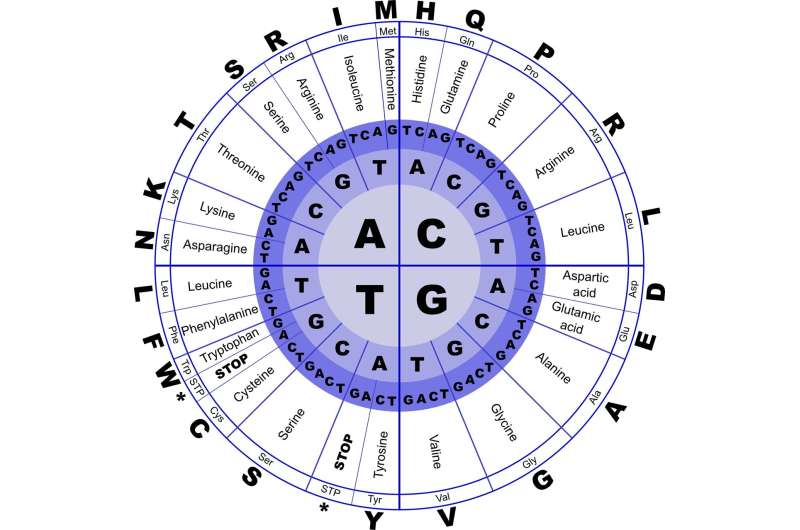This article has been reviewed according to Science X's editorial process and policies. Editors have highlighted the following attributes while ensuring the content's credibility:
fact-checked
peer-reviewed publication
trusted source
proofread
The end of genes: Routine test reveals unique divergence in genetic code

Scientists testing a new method of sequencing single cells have unexpectedly changed our understanding of the rules of genetics.
The genome of a protist has revealed a seemingly unique divergence in the DNA code signaling the end of a gene, suggesting the need for further research to better understand this group of diverse organisms.
Dr. Jamie McGowan, a postdoctoral scientist at the Earlham Institute, analyzed the genome sequence of a microscopic organism—a protist—isolated from a freshwater pond at Oxford University Parks. The research was published in PLoS Genetics.
The work was intended to test a DNA sequencing pipeline to work with very small amounts of DNA, such as DNA from a single cell. Dr. McGowan was working with a team of scientists at the Earlham Institute and with Professor Thomas Richards' group at the University of Oxford.
But, when researchers looked at the genetic code, the protist Oligohymenophorea sp. PL0344 turned out to be a novel species with an unlikely change in how its DNA is translated into proteins.
Dr. McGowan said, "It's sheer luck we chose this protist to test our sequencing pipeline, and it just shows what's out there, highlighting just how little we know about the genetics of protists."
It is hard to make any statements about protists as a group. Most are microscopic, single-celled organisms like amoebas, algae, and diatoms, but larger multicellular protists exist—such as kelp, slime molds, and red algae.
"The definition of a protist is loose—essentially it is any eukaryotic organism which is not an animal, plant, or fungus," said Dr. McGowan. "This is obviously very general, and that's because protists are an extremely variable group.
"Some are more closely related to animals, some more closely related to plants. There are hunters and prey, parasites and hosts, swimmers and sitters, and there are those with varied diets while others photosynthesise. Basically, we can make very few generalizations."
Oligohymenophorea sp. PL0344 is a ciliate. These swimming protists can be seen with a microscope and are found almost anywhere there is water.
Ciliates are hotspots for genetic code changes, including reassignment of one or more stop codons—the codons TAA, TAG, and TGA. In virtually all organisms, these three stop codons are used to signal the end of a gene.
Variations in the genetic code are extremely rare. Among the few variants of the genetic code reported to date, the codons TAA and TAG virtually always have the same translation, suggesting that their evolution is coupled.
"In almost every other case we know of, TAA and TAG change in tandem," explained Dr. McGowan. "When they aren't stop codons, they each specify the same amino acid."
DNA is like a blueprint of a building. It does not do anything in and of itself—it provides instructions for work to be done. In order for a gene to have an impact, the blueprint must be "read" and then built into a molecule which has a physical effect.
For DNA to be read, it is first transcribed into an RNA copy. This copy is taken to another area of the cell where it is translated into amino acids, which are combined to make a three-dimensional molecule. The translation process starts at the DNA start codon (ATG) and finishes at a stop codon (normally TAA, TAG, or TGA).
In Oligohymenophorea sp. PL0344, only TGA functions as a stop codon—although Dr. McGowan found there are more TGA codons than expected in the ciliate's DNA, believed to compensate for the loss of the other two. Instead, TAA specifies lysine and TAG specifies glutamic acid.
"This is extremely unusual," Dr. McGowan said. "We're not aware of any other case where these stop codons are linked to two different amino acids. It breaks some of the rules we thought we knew about gene translation—these two codons were thought to be coupled.
"Scientists attempt to engineer new genetic codes—but they are also out there in nature. There are fascinating things we can find, if we look for them.
"Or, in this case, when we are not looking for them."
More information: Identification of a Non-Canonical Ciliate Nuclear Genetic Code Where UAA and UAG Code for Different Amino Acids, PLoS Genetics (2023). doi.org/10.1371/journal.pgen.1010913
Journal information: PLoS Genetics
Provided by Earlham Institute




















